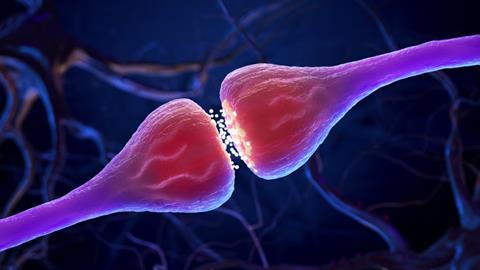Chinese researchers present new biosensors for real-time visualization of neuropeptides in Science. ‘Regardless of the research question, this technique is an enrichment for everyone conducting research on peptidergic neuromodulation.’
Neuropeptides function as neuromodulators, transmitting signals between nerve cells. Over 100 different neuropeptides have been described, and in the brain, they are involved in a wide range of functions, including metabolism, sleep, reproduction, stress and cognition. G-protein-coupled receptors (GPCRs) play a crucial role as receptors for neuropeptides, making them essential in transmitting signals. This receptor group is therefore a promising target for drugs against various conditions, including obesity and insomnia. However, it is necessary to precisely know where and when a specific neuropeptide binds to its corresponding GPCR.
Until now, suitable experimental techniques to track real-time neuropeptide release were lacking. Existing methods measure changes in enzyme activity or gene expression, providing only indirect information about neuropeptides and their receptor.
GRAB sensors
A possible solution is provided by the so-called GRAB sensors, and the research group led by Yulong Li (Peking University, Beijing) now introduces an extension of this technology. The well-known green fluorescent protein cpGFP (cp: circularly permutated) is coupled to GPCR receptors. When the targeted neuropeptide binds to one of the transmembrane loops of the receptor, the conformation of the GPCR protein changes, resulting in increased fluorescence of cpGFP.
Previously, finding the optimal binding site for cpGFP to GPCR was challenging, but Li’s team has developed a universal method to quickly create the right sensor for many different GPCR-neuropeptide receptors. With their new technique, the Chinese team has already developed GRAB sensors for various neuropeptides, including cholecystokinin (CCK), neurotensin (NTS), somatostatin (SST), and neuropeptide Y (NPY), and they believe it can be applied to almost all neuropeptide-GPCR combinations.
Validation
The Li lab has not only developed a large number of different GRAB sensors but has also performed extensive in vitro and in vivo validation. Studies in mice demonstrated that these biosensors are effective not only in cell cultures but also in more complex biological systems. According to dr. Danai Riga, a postdoctoral researcher at the Translational Neuroscience Department of Utrecht University Medical Center, the high-quality validation of the sensors’ efficacy, with different complementary techniques, is one of the reasons the research is published in Science.
‘Additionally, regardless of the research questions, this technique is an enrichment for everyone conducting research on peptidergic neuromodulation’, Riga continues. ‘The questions you can now answer are endless. Neuropeptides are involved in many processes, from digestion and anxiety to cognition, you name it! The technique is really impressive and I think many people will adopt this tool and use it in their own research.’
Icing on the cake
The research group where Riga works certainly is. One of their projects focuses on whether NPY, derived from NPY neurons in a central nucleus in the brainstem, is able to reduce stress responses in mice. Although the first version of their manuscript is already prepared, the new GRAB biosensor may be the icing on the cake, providing conclusive evidence for Riga’s findings. ‘We can now directly demonstrate whether the decrease in anxiety after NPY neuron stimulation is really explained by the release of the NPY peptide in awake, behaving animals,’ Riga says. This direct confirmation was not possible before with the available techniques.
Riga was already aware of the GRAB sensors. ‘Late 2022, we contacted the Li Lab about the biosensors. Their article was already available on bioRxiv, and they were very open about their research on Twitter. Anyone interested in the biosensor could contact the lab. They want people to use their technology.’
In October 2023, the biosensor arrived in Utrecht. The first mice have now been injected with the virus expressing the GRAB sensor. As far as Riga knows, they are the first to test the GRAB-NPY sensor in living animals. ‘So, it is actually a pilot and a bit of trial and error. We have to determine the viral concentration ourselves. You want to induce enough expression of the sensor, without damaging the cells. Also, we do not know yet if the sensor emits enough fluorescence in vivo. The mice are still alive and well,’ says Riga. ‘But whether we can measure fluorescence remains to be seen.’













Nog geen opmerkingen